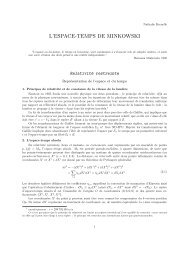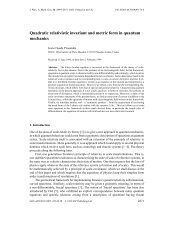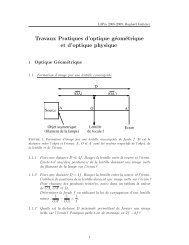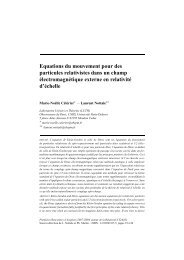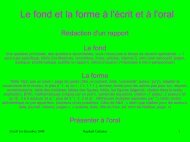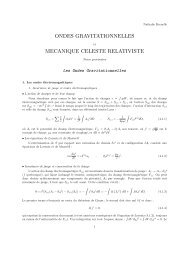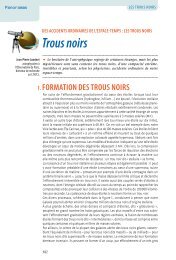Equation of state for compact stars Lecture 1 - LUTh
Equation of state for compact stars Lecture 1 - LUTh
Equation of state for compact stars Lecture 1 - LUTh
You also want an ePaper? Increase the reach of your titles
YUMPU automatically turns print PDFs into web optimized ePapers that Google loves.
Formation <strong>of</strong> the crust in newly born neutron <strong>stars</strong><br />
NS is born as a very hot object - T ∼ 10 11 K. Cools rapidly due to neutrino<br />
emission, and within hours the bulk <strong>of</strong> outer 1% <strong>of</strong> mass has T < 10 10 K, and<br />
within a year it gets cooled to ∼ 10 9 K.<br />
Mass fractions <strong>of</strong> different constituents <strong>of</strong> the outer<br />
envelope <strong>of</strong> a newly born neutron star versus matter<br />
density in beta equilibrium at different temperatures<br />
T9 = T/(10 9 K) (after Haensel et al. 1996).<br />
Calculations are per<strong>for</strong>med <strong>for</strong> the Lattimer & Swesty<br />
(1991) model <strong>of</strong> nuclear matter with a specific choice<br />
(K0 = 220 MeV) <strong>of</strong> the incompressibility <strong>of</strong> cold<br />
symmetric nuclear matter at the saturation density.<br />
After one year the thermal effects <strong>for</strong><br />
ρ > 10 6 g cm −3 are negligible T = 0 approximation<br />
<strong>for</strong> the EOS is fine. Simplifying assumptions: single<br />
A, Z-nucleus; crust in the ground <strong>state</strong>.<br />
Pawe̷l Haensel (CAMK) EOS <strong>for</strong> <strong>compact</strong> <strong>stars</strong> <strong>Lecture</strong> 1, IHP Paris, France 28 / 54





